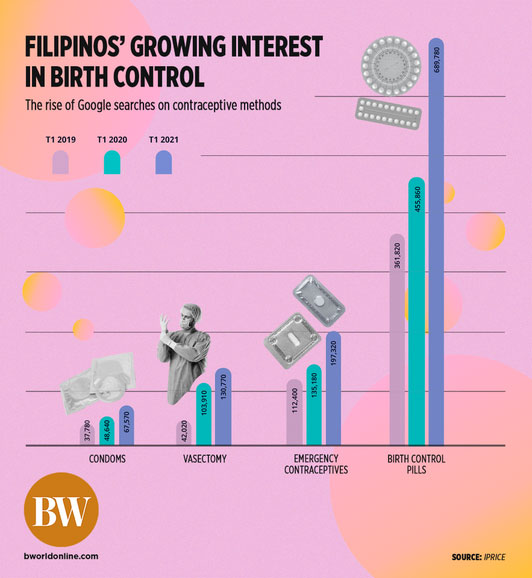Interest in birth control rises, but unplanned pregnancies remain high

FILIPINOS’ interest in contraceptives and birth control methods surged by 96% in the first trimester of 2021 compared to the same period of 2019, according to a recent study that tracked the Google search volume of related keywords in the Philippines.
Birth control pills garnered the most attention online, with a 91% increase in 2021 from 2019, data collected by Southeast Asian e-commerce platform iPrice Group showed, with interest peaking in March 2021, resulting in over 180,000 searches. Meanwhile, searches on condoms, the most accessible form of birth control, rose by 79%. Emergency contraceptives, known as “morning after” pills, increased by 76%.
Even vasectomy, a permanent sterilization for men, experienced a 211% increase in Google searches over the study’s two-year span. It saw an all-time high in November and Dec. 2020.
The iPrice study noted peaks during the last four months of 2020 (also called the “–ber” months). Since then, search volume has continued on a steady upward slope, raising the question of whether Filipinos are being more cautious than ever when it comes to family planning.
INTEREST ≠ USAGE
While iPrice data on online searches show that Filipinos are wary of the consequences of having unwanted children during the coronavirus disease 2019 (COVID-19) pandemic, statistics from population agencies paint a different picture.
The Philippines has one of the highest population growth rates in Southeast Asia, according to the Commission on Population and Development (POPCOM), especially with birth control being less accessible due to the lockdown. In June 2020, the commission projected a 2.2% decline in contraceptive prevalence rate (CPR), meaning a decline in women who use modern contraception and family planning methods.
POPCOM also cited the University of the Philippines Population Institute (UPPI) and the United Nations Population Fund (UNFPA), which predicted nearly 2 million Filipino women between 15 to 49 years old getting pregnant — leading to 214,000 unplanned births.
More alarming is the projection of 10% of births being among women below 20 years of age. POPCOM corrected their estimate of teen pregnancies to 178,000 from the initial 163,000, an increase of 9.3% brought about by the lockdown hampering family planning programs and accessibility to contraceptives.
TEEN MOMS
In order to address teenage pregnancies in the country, POPCOM recently teamed up with the Department of Social Welfare and Development (DSWD) to undertake the Social Protection Program for Teenage Mothers and their Children (SPPTMC). The two parties signed a memorandum of agreement on June 10 to formalize the partnership.
“Through this linkage for the SPPTMC, let it be known by all Filipinos that the government is responsive to the call of its people in addressing the most important problem of women today, which is early childbearing and motherhood, as evidenced by more than 160,000 adolescent minors who are projected to be heads of families this year,” said Undersecretary and POPCOM executive director Juan Antonio A. Perez III during the signing.
The SPPTMC aims to significantly reduce the number of teenage pregnancies by half in the next few years through data gathering, research, mobilization, and sharing and exchange of databases and advocacy campaigns.
As of now, it remains to be seen if teenage pregnancies and population growth will slow down in the future. Though the study on Filipinos’ Google searches doesn’t directly relate to an increase in access or usage of contraception in the Philippines, there is — at the very least — growing interest in it. — Brontë H. Lacsamana



